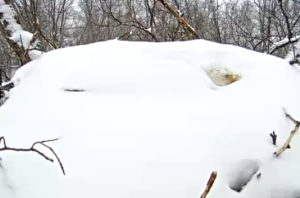As I write we have passed through another false spring and are back to winter, at least it seems that way on the surface. Roads are bad, but the house is warm and the birds are fed. A typical February day, but if you look closely things are shifting to spring one aspect at a time.
The first flowers of spring are waking. In swamps, the alien-looking blooms of skunk cabbage- spotted purple horns with yellow spikes inside are beginning to poke themselves up through leaf litter and even melt through snow, emitting a wonderful stink to attract pollinating flies, which also wake up on warm days. The cabbage blooms are surrounded by springtails, or snow fleas (not really fleas) on the forest floor, sometimes gathering en masse on the edge of flooded areas, driven out of their homes by meltwater. Nearby, the buds of willows are getting ready to open- some already are, providing additional pollen for early insects. If you look closely at the snow, you can often find spiders too- how cold-blooded creatures can be active in the cold amazes me.
Sap is already flowing in maple trees, a miracle of spring. Sap moves up all tree trunks in spring, but not always with the vigor it does in the maples. People who make syrup are already busy tapping as the flow starts and stops, depending on weather. A more reliable flow should be happening soon.
 Even though its snowing, cardinals and chickadees are singing their spring songs- we can hear them from inside the house. Such optimists! Perhaps that’s influenced by never having to shovel show. Other birds are already nesting. In Manitowoc County, at least two of the bald eagle nests that volunteers are monitoring have birds sitting steadfastly inside, presumably incubating eggs. Not always as visible, great horned owls are doing the same. They begin their reproductive year in February because it takes a long time for their large young to develop. They will be ready to leave the nest in May or June when prey will be more abundant than it is now. Females do most of the incubation, while males hunt and bring food back to the nest. Last year, bald eagles nested in every county in Wisconsin, for the first time in a long time. However, avian influenza took a toll on them, and many young birds and some adults were lost. Both nests I monitored last year failed- all the young died. But this year, the adults are back on eggs once again, continuing a life cycle millions of years in the making.
Even though its snowing, cardinals and chickadees are singing their spring songs- we can hear them from inside the house. Such optimists! Perhaps that’s influenced by never having to shovel show. Other birds are already nesting. In Manitowoc County, at least two of the bald eagle nests that volunteers are monitoring have birds sitting steadfastly inside, presumably incubating eggs. Not always as visible, great horned owls are doing the same. They begin their reproductive year in February because it takes a long time for their large young to develop. They will be ready to leave the nest in May or June when prey will be more abundant than it is now. Females do most of the incubation, while males hunt and bring food back to the nest. Last year, bald eagles nested in every county in Wisconsin, for the first time in a long time. However, avian influenza took a toll on them, and many young birds and some adults were lost. Both nests I monitored last year failed- all the young died. But this year, the adults are back on eggs once again, continuing a life cycle millions of years in the making.When I’m outside at night and am lucky, I hear coyotes singing, as this is their mating time too. Same for foxes. i know some people are fearful of such “predators”, but I don’t thiink such fears are justified. After mating, females will use a den to birth and raise their pups. This is the only time of year they typically use such dens. The rest of the time they are able to live outside just fine.
Even under the ice, spring-spawning fish are moving upstream. In a few weeks, suckers will move up from Lake Michigan to spawn, and other fish like smelt. These runs were a cause for excitement when I was young, growing up at Manitowoc Rapids. The old dam would bottle up the fish and make netting them more fruitful. Of course, then there was the cleaning of them in the middle of the night.
Next week is March, the real beginning of biological spring here. Soon, every single day brings something new for the year, for those of us who appreciate the dynamics of nature in this part of the world.
Photo- bald eagle in snowy nest, by Pennsylvania Game Commission
